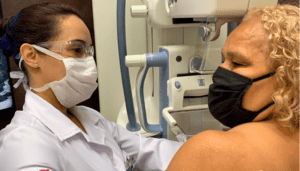Several recommendations on the management of breast cancer screening and diagnosis during the COVID-19 pandemic have been proposed by several medical societies and institutions around the world. The goal has always been to balance the benefits of being diagnosed with a life-threatening illness when not properly diagnosed and treated, with the potential risk of exposure, spread or even death from COVID-19.
The new and disconcerting enigma “risk versus benefit” considers the degree of suspicion of the patient having breast cancer and, additionally, the importance of the information obtained with the imaging method for the clinical decision. Thus, symptomatic women (palpable nodule, suspicious papillary flow, among others) or with suspicious findings in previous exams (BI-RADS® 4 or 5), in locoregional or systemic staging for breast cancer, or in assessing response after neoadjuvant chemotherapy should continue investigation. Percutaneous biopsies of suspicious findings and presurgical markings should also be continued. This decision, whenever possible, should be in conjunction with the referring physician, who has a more adequate knowledge of the patient's clinical risk factors in relation to COVID-19.
The great dilemma is the patients who are not considered urgent: women who are performing the control of probably benign findings (BI-RADS® 3) and, mainly, asymptomatic women who are being screened, with usual risk or even those at high risk for breast cancer. The question is: do we bring these patients to the clinic and generate a potential risk of exposure and contamination for them, the technicians and technologists, the support team and radiologists for an examination that is unlikely to result in breast cancer? This answer is difficult and complex. Most guidelines still recommend postponing these exams. But the problem is that the breast radiologist has always worked to meet the immediate needs of patients, assuage their fears and streamline their care. How disconcerting it is now that we are confronted with a new vision of the risk versus benefit equation.
But how long can we safely postpone these exams? Perhaps this answer does not exist. Because there is no security when we postpone the detection of a cancer that can be cured in an early stage. Therefore, planning the return to activities for carrying out elective exams must take into account the epidemiological status of each region. In places where the number of COVID cases is still high or on the rise, what we can do is start planning a return to activities to reverse this situation as quickly as possible: make a list of all patients canceled during the pandemic, to that they are the first to be scheduled; among the patients who were postponed, make a list of priorities for care: initially the women in high-risk screening, followed by the patients in control of BI-RADS findings® 3 and after screening women with usual risk of breast cancer. Other measures such as planning for additional shifts to work in between or at night, as well as on weekends, can help. But it is clear that in a country where access to tests has always been difficult, even in pre-pandemic times, it will certainly not be an easy task to reverse this situation.
On the other hand, in regions where the peak of the pandemic has passed and new cases are stabilized, where social isolation measures are being relaxed, elective exams can now be considered. But for this it is necessary that all the safety recommendations described in the “General COVID-19 infection prevention recommendations for hospital imaging clinics and services”, published by the Brazilian College of Radiology (available on the website: www.cbr.org.br), as well as in the Technical Note “Guidelines for the prevention of transmission of COVID-19 within health services (GVIMS/GGTES/ANVISA No. 07/2020), published by ANVISA, are complied with to ensure safety for patients and health professionals. It is important to emphasize that the final decision to carry out an elective exam should always occur when the doctor and the patient conclude that the “risk versus benefit” equation is appropriate, while trying not to extrapolate a maximum period of interval between exams of 18 months.
Finally, Brazil is a continental country and the measures and strategies adopted in a service or hospital may depend on the individual organization, the resources of the institutions and the epidemiological situation of each region, and may not be the same for other locations. But, as in other countries, we will return to “normality”. And make it as brief as possible.
Committee on Mammography, CBR




